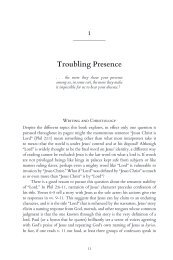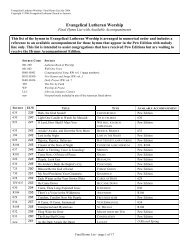19. Pastoral Letters: 1 Timothy, 2 Timothy, Titus - Augsburg Fortress
19. Pastoral Letters: 1 Timothy, 2 Timothy, Titus - Augsburg Fortress
19. Pastoral Letters: 1 Timothy, 2 Timothy, Titus - Augsburg Fortress
Create successful ePaper yourself
Turn your PDF publications into a flip-book with our unique Google optimized e-Paper software.
Copyrighted Material<br />
1 <strong>Augsburg</strong> timothy, <strong>Fortress</strong> 2 timothy, Publishers titus 449<br />
more that of eschatological witness, as 2:13 makes evident. Here we see the sharpness<br />
of Paul’s thought elsewhere: the Christian lives on the cusp of the new age and the old<br />
(2:12-13). Indeed, the admonition for Christian faithfulness rests in these two fundamental<br />
and widely attested Pauline axioms: Jesus has redeemed his people (2:14) and<br />
he is coming in glory to establish them eternally (2:13).<br />
Study Questions<br />
1. What difference would it make in our understanding of Paul if he did not write these<br />
letters? In our understanding of the history of the church?<br />
2. Considering all the New Testament references, what was Paul’s relationship with<br />
<strong>Timothy</strong>?<br />
3. What difference does it make that these letters are addressed to individuals rather<br />
than congregations?<br />
4. How does attention to “letter types” help in the interpretation of these compositions?<br />
5. What role do metaphors of the family and household play in these letters? What<br />
would account for this?<br />
Bibliographical Note<br />
Good summaries of the issues pertaining to authenticity are found in W. G. Kümmel,<br />
Introduction to the New Testament, trans. H. C. Kee (Nashville: Abingdon Press, 1975),<br />
366–87; and E. E. Ellis,“The Authorship of the <strong>Pastoral</strong>s: A Resume and Assessment of<br />
Recent Trends,” in his Paul and His Recent Interpreters (Grand Rapids: Eerdmans,<br />
1961), 49–57. For the discussion of specific points, see the classic study by P. N. Harrison,<br />
The Problem of the <strong>Pastoral</strong> Epistles (London: Oxford Univ. Press, 1921), as well as<br />
the more recent ones by R. F. Collins, <strong>Letters</strong> That Paul Did Not Write: The Epistle to the<br />
Hebrews and the Pauline Pseudepigrapha (Wilmington: Michael Glazier, 1988), 88–131;<br />
L. R. Donelson, Pseudepigraphy and Ethical Argument in the <strong>Pastoral</strong> Epistles (Tübingen:<br />
J.C.B. Mohr [Siebeck], 1986); K. Graystone and G. Herdan, “The Authorship of<br />
the <strong>Pastoral</strong>s in the Light of Statistical Linguistics,” NTS 6 (1959–60): 1–15; and J. D.<br />
Miller, The <strong>Pastoral</strong> <strong>Letters</strong> as Composite Documents (SNTSMS, 93; Cambridge: Cambridge<br />
Univ. Press, 1997). See also the vocabulary studies by D. Cook, “2 <strong>Timothy</strong><br />
IV.6–8 and the Epistle to the Philippians,” JTS 33 (1982): 168–71; and “The <strong>Pastoral</strong>




